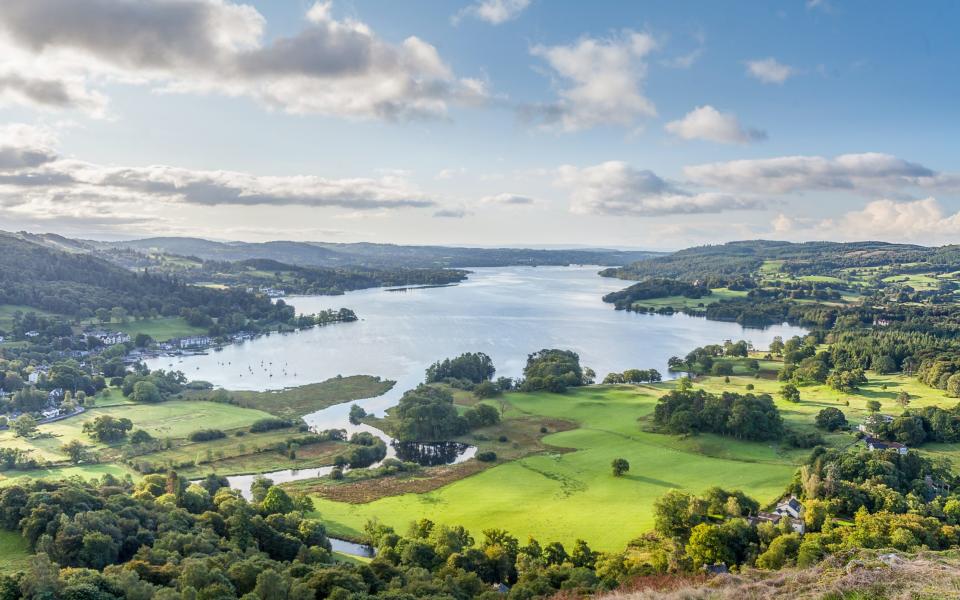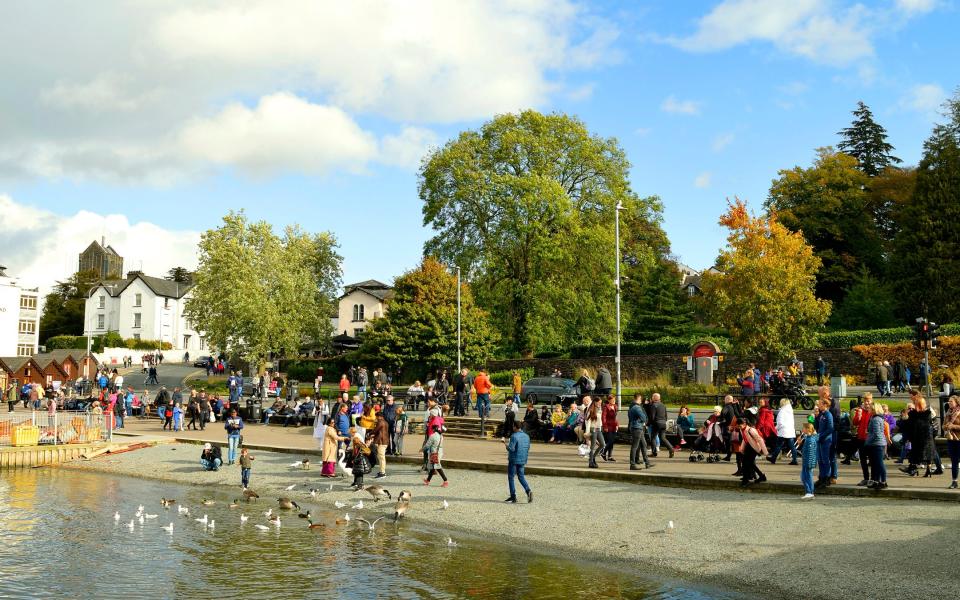‘Tourists relieve themselves in my garden and then abuse my staff’

“You see all sorts bobbing about on the Lakes,” says Eleanor Ormrod, a 24-year-old nail technician and keen paddleboarder from Kendal. Like many locals in the Lake District National Park – which extends across 2,000 sq km of Cumbria and is home to England’s highest mountain (977m Scafell Pike) and the country’s longest and deepest bodies of water (Windermere and Wastwater, respectively) – Ormrod has become a have-a-go local litter picker.
“Lakeside we get disposable barbecues, tents, used vapes and weird stuff like abandoned footballs,” Ormrod explains of this unfortunate tide. “On the water it’s usually plastic bags and bottles.”
When Ormrod is out on the handsome cobalt expanses of Lake Windermere, she routinely paddles up to floating masses of rubbish to nudge them to shore and the nearest bin. “It makes me sad to think what else has sunk to the bottom to harm all the wildlife there,” she adds.
For the romantic poet Wordsworth, the Lake District was beautified by a “host of golden daffodils… fluttering and dancing” in the lakeside breeze. Today it’s fluttering rubbish that dances across these once-pristine landscapes, as local groups including Friends of the Lake District and the delightfully named Wombles of Windermere respond to tourist-borne deluges of plastic, beer bottles and soiled nappies by setting up litter collection groups, and voluntourism offerings that combine walking with litter picking, such as the Real3Peaks Challenge.

Around 40 million tourists a year visit the Lakes, with the national park being one of the winners, or losers (depending how you see it), of Covid’s onus on domestic travel and the great outdoors, seeing 16 million domestic tourists in 2021 to hubs such as Keswick, Bowness and Ambleside, in an influx that has been supercharged by the region’s rising Instagram and TikTok fame.
On the plus side, tourism supports around 30,000 jobs in the Lake District (equivalent to 26 per cent of Cumbria’s working age population), and generates £2 billion in revenue each year. Yet with an estimated shortage of 50,000 car-parking spaces across the region, and terrible public bus and rail infrastructure (many of the major train stations founded for the tourist trade, such as Keswick and Cockermouth, were closed during the 1960s Beeching rail cuts and buses cost up to £7 for short journeys), the Lakes are ill-equipped, locals say, to accommodate these millions of annual guests.
Ryan Blackburn, 43, is chef patron of the Michelin-starred Old Stamp House in Ambleside and was born and raised in the region. The restaurateur welcomes the business income he sees from tourists, as well as the quality local services that are propped up by Lakes incomers, including second homeowners. “Look at Cockermouth’s fabulous fishmongers, bakers, cafés and bookshops,” he says, “and all the Michelin stars we have [in the Lakes] now”.

However, Blackburn says that shortages of housing, parking, loos and civic and transport infrastructure cause acute stress for locals and tourists alike.
Blackburn recently had to install locks on his Ambleside restaurant bins as the lack of public bins in the small town was leading to his backyard becoming a mass rubbish heap for passing tourists. The same backyard sees tourists relieving themselves due to the Lakes’ lack of public loos. “My young staff get loads of abuse from people pissing there,” he complains.
Yet Blackburn – who says he can no longer afford to live in the Lakes due to the number of Airbnbs dominating the region’s housing supply – doesn’t blame incomers. Instead he feels that local landowners and councils renege on their obligations.
“The local authority is really keen to slap tourists with huge parking fines, but not to provide adequate parking spaces,” he says, “and our tourist board is always off in places like China and Japan selling Cumbria as a destination, yet we don’t have the parking, cafés, toilets or transport to deal with the tourists we have already.”

The Lake District is not unique in seeking holidaymaker cash without sufficiently improving infrastructure, says Rachel Dodds, who studies overtourism at Ryerson University, Toronto. A shortage of public loos around New York’s Times Square and The Taj Mahal in India have in recent years led to tourists “wild toileting”, while the Scottish Highlands has similarly poor road and rail links.
“Ensuring that a destination is first and foremost a good place to live, not only a good place to visit, is key,” Dodds explains. “Decent infrastructure – both its development and maintenance – conserves and protects the very resources that attract visitors in the first place, preventing these resources from becoming polluted and overcrowded.”
In short, locals and tourists alike have an interest in natural spots not being draped with crisp packets or pretty towns turned into open-air lavatories.
Life coach Karen Whybrow, 44, lives on the West Cumbrian coast at Seascale and grew up in the Lakes, returning here from Essex when she was widowed in 2022. She finds humour in her encounters with ill-prepared tourists on Scafell Pike “dressed in city shoes with no clue, food or a map”, but is annoyed that locals have to collect litter on beautiful Scafell – “bags and bags of the stuff every day” – and says road closures in order to crane jammed SUVs out of hairpin bends are “vexing” for locals.

“[Tourists] blindly follow their satnavs and get stuck,” she says of the SUVs. “Then emergency services can’t get through.” With a high proportion of over 65s boosted by retirees (23 per cent compared to 18 per cent nationwide), Lakes NHS services are under acute pressure in the summer months.
Ali Phillips, 29, spoke to Telegraph Travel on a sunny September day from the banks of Ullswater, the region’s second largest lake. A Keswick-based blogger and swim guide, Phillips has seen a notable shift in the demographics of Lakes tourists since the Covid years, from the walking boot brigade to families and young couples seeking paddleboarding and wild swimming adventures.
“Every family has a paddle board on their roof now you can buy them for £100 from Lidl,” she notes of the watersports boom, adding: “That’s great, but it does mean loads more people are spending time on the water and at the water’s edge, bringing all their food and things with them.”
On her instagram page Girl About the Lake District, Phillips advises tourists how to get to major natural spots via public transport rather than car. Her chief bugbear is the rise of ‘hidden gem’ and ‘secret spots’ social media channels and posts, which satisfy users’ appetites to seek out remote and photogenic locations.

“There’s this spot on the north-eastern side of Thirlmere that’s on Instagram all the time as ‘Thirlmere infinity pool’ because it looks like a [hotel] infinity pool if you take a photo of it from a certain angle,” she explains. “But it’s really challenging to trek there and the path is becoming eroded with the thousands of people who scramble up.”
Eleanor Ormrod also bemoans how TikTok has spoilt formerly unblemished spots such as Wasdale Fairy Pool (a blue lake at the foot of a waterfall) and Black Moss Pot in Keswick, dubbed a “magical wild swimming pool” on videos featuring pumping dance soundtracks. “The ‘fairy pool’ thing is really quite odd,” she notes.
For the Windermere Wombles, recent complaints centre around used nappies strewn across a lakeside road and the unthinking removal of bins from Windermere train station and surrounds.
Phillips believes that one solution to the Lake District’s woes would be a tolled tourist park-and-ride to fund services, an idea that’s been mooted since 2010 and is used to manage tourist coaches in some Italian honeypots. “At the end of the day tourists bring loads to the area and we need them not to have a miserable time when they get here,” she says.
In 1810 the poet William Wordsworth concluded his guide to the Lakes with a hope that the English Lake District might be “deemed a sort of national property in which every man has a right and interest who has an eye to perceive and a heart to enjoy”. In 1951 Wordsworth’s vision became reality when the Lake District was given protected status. Seventy years on, and a lot of strewn pop bottles later, it’s time for our finest national parks to become something we can all treasure.


